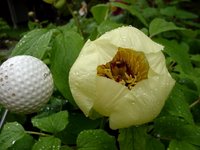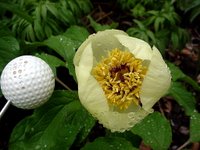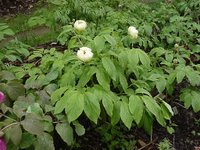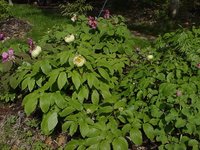
The flowers open a soft yellow (well within the range of yellow of the better-known yellow, mlokosewitschii) and will fade to ivory by the time the petals drop; you can see a bit of the fading of the same flower, between the first two photos. The centre is exquisite with dark red filaments and
 stigmas, is mildly fragrant, and doesn't open much further than in the second and third photos, remaining globular in shape. There are also white-flowered plants which are also great, and one of my seedlings has a fine red edging to the petals, probably the
stigmas, is mildly fragrant, and doesn't open much further than in the second and third photos, remaining globular in shape. There are also white-flowered plants which are also great, and one of my seedlings has a fine red edging to the petals, probably the  influence of inadvertent hybridizing. (due to a camera malfunction I don't have a photo of these variants). First bloom here this year was on 27 May.
influence of inadvertent hybridizing. (due to a camera malfunction I don't have a photo of these variants). First bloom here this year was on 27 May.The third photo is of a plant of the "high altitude form", but I don't see any difference from the rest of mine. I include it because the raindrops appeal to my artistic side.

P steveniana is one of a few synonyms for a plant which some botanists classify as Paeonia wittmaniana subsp macrophylla. The foliage is lush, soft-textured and a bit droopy in an attractive way; the leafs are
 pointed and quite large with clearly visible vein patterning.
pointed and quite large with clearly visible vein patterning.It is native to the region of the Caucasus and nearby, growing in forests and amongst shrubs. They are large plants, up to a metre tall, but like all species peonies are strong-stemmed and do not need support. Mine have flowered a year younger in the open field, but are less vigorous there and in the woodland bed. The photos were all taken at the part-shade bed near the house, where the plants are at their most magnificent.
Seed of my plants was collected from the wild in the southeast of the Republic of Georgia.
Compared to P tomentosa which we saw earlier, this has larger leafs, flowers later (no overlap here), and has the distinctive globular shape to the flower. Yep, a person would really have to have both in their garden!
________________
ignore this bit... I'm trying to figure something out here

No comments:
Post a Comment